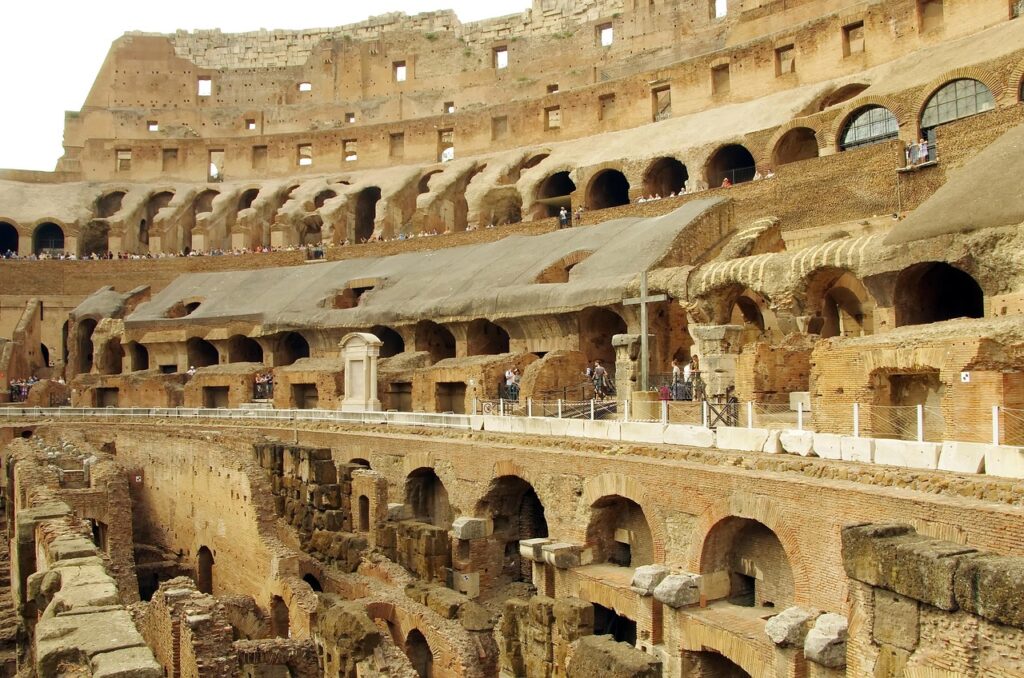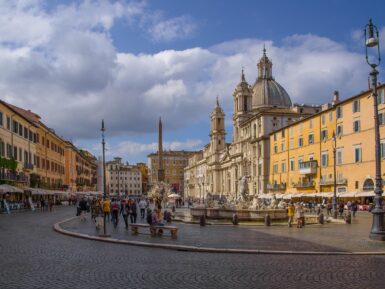Table of Contents
1. History
Colosseum

The Colosseum also known as the Flavian Amphitheater, is the largest and most famous amphitheater ever built, symbol of Roman engineering, military strength and public entertainment culture. Built in 70-80 AD under Emperor Vespasian and completed by his son Titus, this colosseum was designed to host spectacular public events including gladiator battles, animals hunts and theatrical performances. If you’re planning to explore Rome, check out our guide on the 25 Best Things to Do in Rome for more must-visit attractions

Its concentration used concrete and travertine stone, allowing it to accommodate over 50,000 spectators in a tiered seating arrangement based on social class. The hypogeum or underground area housed wild animals, slaves and gladiators before their fights.
Roman Forum

This place was a political, religious and social center of ancient Rome. It functioned as a marketplace, government hub, and gathering place for public life for 1000 years. The forum was originally a marshy valley between Palatine and Capitoline Hills.
By the Republican era (509 BC – 27 BC ),it became the site of government buildings, temples, markets and public squares, where senators debated laws generals celebrated military victories, and citizens gathered for speeches and trails.

However, after the fall of Western roman empire (476 AD) it was gradually abandoned ,buried under centuries of debris and later used s pastureland during the middle ages. Excavations in the 18th and 19th revealed its ruins ,making it one of the most significant archaeological sites in Rome today.
Palatine Hill

This is the legendary birthplace of Rome, where Romulus founded the city in 753 BC. Archaeological findings confirm it was inhabited as early as the 9th century BC, making it Rome’s earliest settlement. During the Republic, it became home to Rome’s elite while under Emperor Augustus, it became the imperial seat of power. But after the fall of Rome (476 AD ) it was abandoned and later repurposed for farming and monasteries.
2. Architecture and Engineering
Colosseum
This masterpiece of roman engineering is designed with concrete and travertine stone to ensure durability. Its tiered seating arrangement reflected Roman social hierarchy while the 80 entrance arches allowed rapid crowd movement a design still used in modern theaters.

Beneath the wooden and sand covered arena floor lay the Hypogeum and elaborate underground network of tunnels, elevators and trapdoors facilitated the movements. The Velarium was a retractable awning that provided shade for spectators, showing Roman skill in keeping people comfortable.
Though some earthquakes and stone looting have ruined the masterpiece but the advanced engineering principals have kept much of it standing.
Roman Forum

This place is the center of ancient Rome was engineered with grand temples, basilicas and triumphal arches, supported by the Cloaca Maxima one of the world’s oldest sewage systems.
Its rectangular layout connected key landmarks via the Via Sacra with Basilicas featuring vaulted ceilings temples adorned with Corinthian columns and arches built from concrete and travertine.
Palatine Hill

The hill was built on solid rock, making it strong enough to support large palaces, temple and gardens. The domus Augustana and Domus Flavia used brick, concrete and marble columns while the stadium of Domitian has tiered seating and hidden passages. A water system brought water to its fountain and baths, showing Roman skills in building luxury spaces and managing water.
3. Best Time to Visit
Mornings 08:30 am to 10:00 am are the best time to visit right after it opens to avoid crowd, cooler temperatures, and great photos.
Even the evenings between 04:00 pm to 06:00 pm are one of the best time to visit for soft sunlight pictures and more good weather.
Springs (March-May) and falls (September – November) are the best season to visit for Pleasant weather, blooming flowers and comfortable temperatures and stunning golden hour views respectively.
Avoid Midday (11:00 am – 03:00 pm ) and the months of July August for extreme heat and large tour groups.
4. Tickets and Entry Fee
1. Standard Ticket:
- Price: €18.00 for Adults.
- Reduced Fare: €2.00 for EU citizens aged 18 to 24.
- Access: Includes entry to the Colosseum, Roman Forum, and Palatine Hill.
- Validity: Valid for 24 hours from the first use.
- Booking: Available through the official website
2. Full Experience Ticket:
- Price: €24.00 per person.
- Access: Grants access to special areas such as the Arena or Underground, in addition to standard areas.
- Booking: Can be reserved via official channels or authorized tour operators.
3. Guided Tours:
- Price Range: Typically between €40.00 to €60.00 per person, depending on the provider and inclusions.
- Benefits: Offers in-depth insights and often includes skip-the-line privileges.
- Booking: Available through various tour operators like GetYourGuide
TIP :- You can also take The Roma Pass.
What is Roma Pass?

Roma Pass is a kind of card designed to elevate your travelling in Rome, it offers a lot of benefits mention below:
Free Admissions: Depending on the pass duration, enjoy free entry to one or two museums or archaeological sites of your choice in Rome.
Discounts: Enjoy the benefit of reduced prices for several event, exhibitions, and tourist services.
last but not the least one of my personal favorite. Unlimited access to public transport in Rome depend on the validity period.
There are two types of Roma Passes:-
1. Roma Pass 48 hours ( €36.50 )
Include:
- 1. Free entry to one museum or any archaeological site of your choice.
- 2. Reduced ticket prices for all other museums and sites thereafter.
- 3. Discounts on various exhibitions and tourist services.
- 4. Unlimited use of public transport for 48 hours ( hour will start to be counted from your first use
- 5. Free access to toilet services of the P.Stop network.
2. Roma Pass 72 Hours ( €58.50 )
Include:
- 1. Free entry to the first two museums and sites of your choice.
- 2. Reduced ticket prices for all other museums and/or sites thereafter.
- 3. Unlimited use of public transport for 72 hours
- 4. Discounted rate on exhibitions and tourist services.
- 5. Free access to toilet services.
5. Budget Tips
1. Directly purchase tickets from the official sources to avoid the inflated prices from third party websites.
2. Take advantage of the free entry days: First Sundays of every month are free to enter.
3. Utilize free audio guides and apps enhance your visit without the cost of a tour guide by downloading free audio guides . The official “MyColosseum” app offers guides in both Italian and English.
4. Bring your own food rather than relying on the food available nearby these attractions as they are expensive.
5. If you are staying in Rome for a few days and plan to visit multiple attractions, Roma pass will be a cost-effective option.
6. Photography Tips
1. To capture both yourself and the monument in full, use wide angle lens or 0.5x mode on your phone and shoot from low angle to make both you and the monument appear larger and more striking. The best spot to capture colosseum is to stand on Via Nicola Salvi.
2. Rather than standing too close, position yourself 10-20 fee away to emphasize the monument’s grandeur. This creates a balanced composition ,keeping you as the focal point while showcasing the historical setting.
Keep your hands in your pockets and give a natural pose. The best spot to capture roman forum will be from Palatine Hill which offers breathtaking panoramic views.
3. Walk along ancient pathways to create a dynamic shot with depth and walk slowly, look sideways for a candid travel vibe. The best spot to capture will be the path leading to the Arch of Septimius Severus in the Roman Forum.
8. FAQ’s
Why is the Colosseum famous for?
The colosseum is famous for being the largest ancient amphitheater ever built, known for hosting gladiators battles, public spectacles and dramatic performances during the Roman Empire.
How much time do you need to visit the Colosseum?
A ideal visit will take 1.5 hours to 2 hours but a combination of roman forum, palatine hill will be 3-4 hours.
Can you just show up to the Colosseum?
No, advanced booking is required and you can book it online. Mostly same day tickets are sold out.
Is the trevi fountain near the Colosseum?
Yes it near and the distance is 1.6km via dei Fori Imperiali and will take 21 minutes to walk.
Is it free to enter the Roman Forum?
No, advanced booking is required and you can book it online. Mostly same day tickets are sold out.
Is Roman Forum worth visiting?
Yes, the roman forum is one of the most important archaeological sites in the world.
Can you just walk into the Roman Forum?
No, you need a valid Colosseum or combination ticket to enter, and there are designated entrances.
Is there a dress code for the Roman Forum?
No there is not strict dress code but I will suggest you to wear comfortable shoes.
How long does it take to walk around the Roman Forum?
The time spend here on an average will be between 1 to 1.5 hours.
Is the Roman Forum lit up at night?
Yes few parts of the roman forum are lit up.
What is so special about Palatine Hill?
Palatine Hill is one of the most ancient parts of Rome, known as the birthplace of the city and home to imperial palaces with stunning views of the Roman Forum.
Who is buried on Palatine Hill?
Legends says Romulus, Rome’s founder was buried on the hill.
What is the difference between Roman Forum and Palatine Hill?
The Roman Forum was the political, religious, and commercial center of ancient Rome, filled with temples, basilicas, and government buildings. Palatine Hill, located above the Forum, was a residential area for emperors and elite Romans, offering historical palaces and scenic views.





Leave a reply